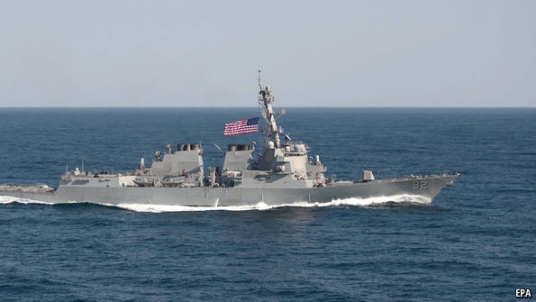THE puzzle about the intrusion on October 27th by an American warship into what China regards as its waters in the South China Sea is not that it took place. Rather it is that the patrol, which the American navy keeps insisting is “routine” practice, had not happened much earlier.
Waving the rules
An American warship sails through disputed waters in the South China Sea
A long-awaited “freedom of navigation” operation is sure to anger China

THE puzzle about the intrusion on October 27th by an American warship into what China regards as its waters in the South China Sea is not that it took place. Rather it is that the patrol, which the American navy keeps insisting is “routine” practice, had not happened much earlier.
The ship, USS Lassen, sailed closer than 12 nautical miles from Subi Reef, one of seven tiny specks in the Spratly archipelago where China has been engaged in frenetic construction over the past two years—in effect creating artificial islands. America fears they are military bases in the making, which would greatly extend China’s military reach. It has called on China to halt all construction.
Advertisement
America called USS Lassen’s sail-by a routine “freedom of navigation” operation (FONOP in the jargon), of a type it conducts all over the world “in accordance with international law”. China reacted furiously, accusing America of having “illegally entered” its waters, threatening “China’s sovereignty and security interests”.
Each side’s position is a bit odd. America insists it is upholding international law, the United Nations Convention on the Law of the Sea (UNCLOS). But it has never ratified UNCLOS (though successive presidents and navy chiefs have unavailingly urged Congress to do so).
It also purports to be protecting the freedom of navigation for the whole world, in sea lanes vital for maritime trade. But no one is actually threatening that freedom using sovereignty as a pretext.

Before authorising USS Lassen’s mission, the Obama administration waited until after President Xi Jinping’s state visit to America earlier in the month, perhaps not wanting to sour the atmosphere. That Mr Xi was so dismissive of American concerns about China’s island-building in the South China Sea seems to have prompted Barack Obama to agree to a FONOP the Pentagon had been urging for months.
By refraining for so long from entering these waters (the last such close sail-by of a feature claimed by China in the South China Sea was in 2012, the year Mr Xi took over as China’s leader), America tacitly accepted that it would be very provocative to China. That has rather undermined its argument that it is no big deal.
America also maintains it takes no view on the sovereignty over disputed islands, rocks and reefs in the sea. Subi Reef, for example, is claimed not just by China but by the Philippines, Taiwan and Vietnam. The limited point the navy has taken so long to make was that, whoever owns it, it would not be entitled under UNCLOS to its own “territorial waters”.
Under UNCLOS, habitable islands are entitled to territorial waters extending 12 nautical miles around their periphery, as well as a 200-nautical-mile “exclusive economic zone” (EEZ). Uninhabitable rocks get the territorial waters but not the EEZ. “Low-tide elevations”—ie, reefs like Subi and two others where China has been filling in the sea that are wholly submerged at high tide—get neither.
China for its part has ratified UNCLOS. Yet it has been reluctant to spell out how its claims in the South China Sea accord with it. Instead it resorts to vague and sweeping historical claims, as Mr Xi did in America: “The islands and reefs in the South China Sea are Chinese territory since ancient times. They are left to us by our ancestors.” That is debatable and, in any event, UNCLOS does not recognise ancestral rights.
China has also produced a map that it says represents its claim, a vast U-shaped “nine-dashed line”, encompassing virtually the entire sea. But it has left vague whether it is claiming the land features within the line, or all the waters as well, which is not how UNCLOS works.
China does appear to accept UNCLOS’s article 17 on the “right of innocent passage”, under which warships can pass freely even through territorial waters if they do so without any menacing behaviour. To no American protests at all, five Chinese naval ships sailed in American waters off Alaska in August—just as Mr Obama was visiting the state. Again, China seems unembarrassed by the inconsistency, and not interested in explaining it.
Part of the reason lies in China’s and America’s different interpretations of UNCLOS as it relates to what foreign navies can get up to. In the past disputes have focused on EEZs, not the 12nm-limit. America thinks it has the right to conduct military exercises and surveillance in EEZs. China disagrees. Several times it has harassed American ships and planes engaged in what it sees as spying. It now seems to hope it is powerful enough to enforce its interpretation. America is, at last, pushing back.
Its friends in South-East Asia will be cheered. But few, if any, will be keen to join in FONOPs themselves. They would rather hide behind America as it seeks to maintain an important component of the Pax Americana that has enabled Asia to thrive for decades.
No comments:
Post a Comment